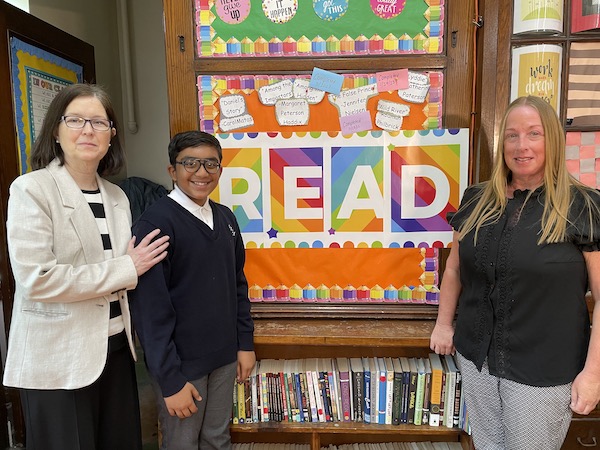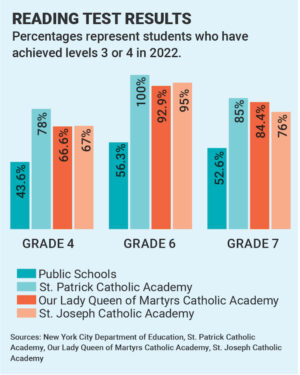
FOREST HILLS — When Mayor Eric Adams announced that New York City’s public schools will be revamping the way they teach children to read and bringing back phonics, you couldn’t blame principals in the Diocese of Brooklyn if they chuckled a little.
Catholic schools have been using the tried-and-true method of phonics for years, and the results of standardized tests indicate that it’s working.
“I’m a huge believer in phonics,” said Kathleen Curatolo, principal of St. Patrick Catholic Academy in Bay Ridge.
In Curatolo’s school, 100% of the sixth graders scored high on the 2022 New York State English Language Arts Examination, meaning that the youngsters achieved the third level (meets standards) or fourth level (exceeds standards).
By contrast, the percentage of sixth graders in public schools achieving third and fourth levels was 56.3%, according to the New York State Department of Education.
The statewide exam was given to students in grades 4, 6, and 7 over a two-day period in April 2022. The results of the April 2023 test have not been released.
Phonics, the method of teaching children to read by having them sound out letters to use different sounds to distinguish one word from another, had largely fallen out of favor in the public school system as schools opted for other methods, like having students match words to pictures.
But as reading scores have fallen, the city is reassessing. On May 9, the mayor announced a new initiative, “New York City Reads.” In his announcement, Adams admitted that “with more than half of our city’s public school students reading below grade level, now is the time to act.”
“Phonics is a really worthwhile approach for many children. To have denied them that opportunity to use that strategy is unfortunate,” said Anne Zuschlag, principal of Our Lady Queen of Martyrs Catholic Academy in Forest Hills, where 92.9% of sixth graders scored high on exams. “So I’m grateful that they are recognizing what we’ve seen all along,”

However, even while basing their lessons on phonics, schools in the diocese use all sorts of concepts to teach students to read.
Luke Nawrocki, principal of St. Joseph Catholic Academy in Long Island City, where 95% of sixth graders scored high, said his school uses “i-Ready,” a program that tracks students’ progress from kindergarten through eighth grade.
“It gives you a sense of where kids are,” he said, adding that problems can be addressed early. Nawrocki also brings in coaches twice a month to assist his English language arts and math teachers.
Teaching reading involves the entire school, not just the individual classroom teacher, he said. “We try to create a positive attitude throughout the building,” he explained. “Everything that happens during the day affects how students learn.”
Some schools use interior decorating to foster the right atmosphere. At St. Patrick’s, one classroom has flexible seating, allowing students to opt for sitting on couches and bean bags, even lying on the rug if they wish.
Teacher Brendan Moloney, who came up with the flexible seating idea, said the school also jazzes things up by mixing old and new to offer “a fresh and rigorous take on classic literature alongside new and modern texts.”
St. Patrick’s uses fun games like “Word of the Week” to keep kids engaged. “If you come into the office and can use the word in a sentence, you win a lollipop,” Curatolo explained.
Seventh and eighth graders at St. Patrick’s take part in Socratic seminars, in which students sit in an inner circle and an outer circle, asking each other questions about the novel they’re reading.
Marybeth McManus, who teaches seventh-grade ELA and social studies at Our Lady Queen of Martyrs, is constantly thinking of new ways to teach.
“We read a variety of different genres throughout the year. And I try to cross-curricular with other subjects, especially with social studies and different things that we’re going to be learning in history,” she explained.
McManus also gives students a say in what the class reads. Her class reads five novels a year. She announces four of them at the start of the year in September and lets the kids vote on the fifth.
Seventh grader James Lukose appreciates the approach. “When we are in class, and we read, it’s kind of fun because it’s a different thing every day,” he said. “Either we’re learning about ELA in a packet or reading a chapter of a book, or doing online activities about the book itself. Every day, it’s something different.”
The class is currently reading “Daniel’s Story,” a novel by Carol Matos that takes place during the Holocaust.
James’ favorite book this year was “Lyddie” by Katherine Paterson.
“It’s basically about this girl who lives in the 1800s, and she’s very poor, and her mother has to pay a lot of debts. So her mother sells her and her brother off to work at jobs,” he said.
While proud of her school’s results, Zuschlag cautioned against putting too much emphasis on test scores. Instead, she said, schools should reinforce a love of reading so it lasts a lifetime.
“I think if we feel that we have children that love reading, then we’re successful,” she explained. “And it demonstrates itself thankfully into great scores because that helps them to feel comfortable about their ability as they move forward into the world.”
